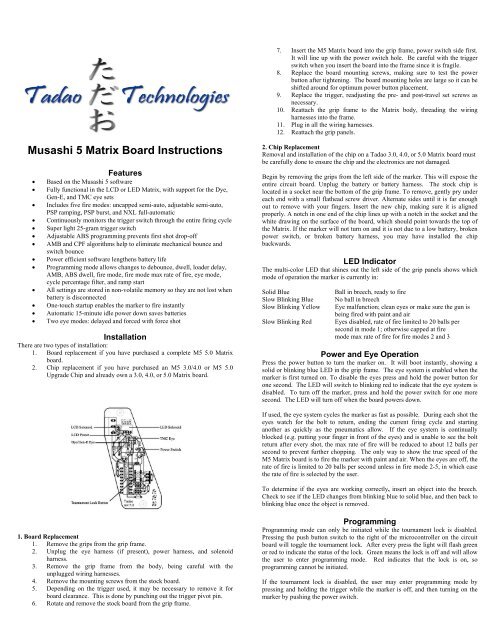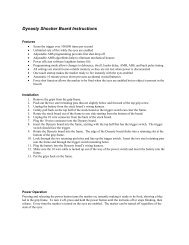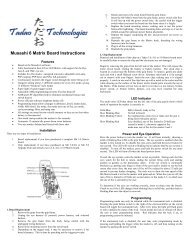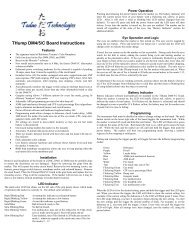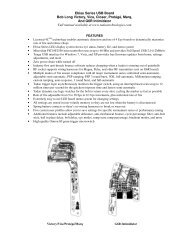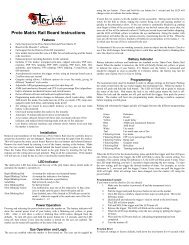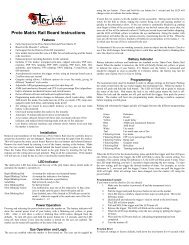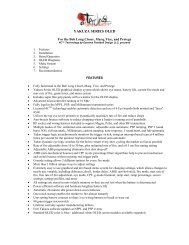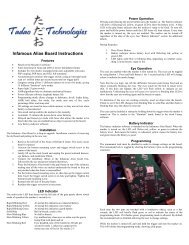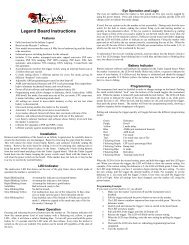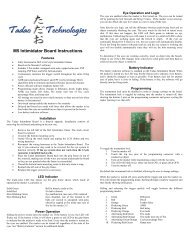Musashi 5 Matrix Board Instructions - Tadao Technologies
Musashi 5 Matrix Board Instructions - Tadao Technologies
Musashi 5 Matrix Board Instructions - Tadao Technologies
You also want an ePaper? Increase the reach of your titles
YUMPU automatically turns print PDFs into web optimized ePapers that Google loves.
7. Insert the M5 <strong>Matrix</strong> board into the grip frame, power switch side first.<br />
It will line up with the power switch hole. Be careful with the trigger<br />
switch when you insert the board into the frame since it is fragile.<br />
8. Replace the board mounting screws, making sure to test the power<br />
button after tightening. The board mounting holes are large so it can be<br />
shifted around for optimum power button placement.<br />
9. Replace the trigger, readjusting the pre- and post-travel set screws as<br />
necessary.<br />
10. Reattach the grip frame to the <strong>Matrix</strong> body, threading the wiring<br />
harnesses into the frame.<br />
11. Plug in all the wiring harnesses.<br />
12. Reattach the grip panels.<br />
<strong>Musashi</strong> 5 <strong>Matrix</strong> <strong>Board</strong> <strong>Instructions</strong><br />
Features<br />
• Based on the <strong>Musashi</strong> 5 software<br />
• Fully functional in the LCD or LED <strong>Matrix</strong>, with support for the Dye,<br />
Gen-E, and TMC eye sets<br />
• Includes five fire modes: uncapped semi-auto, adjustable semi-auto,<br />
PSP ramping, PSP burst, and NXL full-automatic<br />
• Continuously monitors the trigger switch through the entire firing cycle<br />
• Super light 25-gram trigger switch<br />
• Adjustable ABS programming prevents first shot drop-off<br />
• AMB and CPF algorithms help to eliminate mechanical bounce and<br />
switch bounce<br />
• Power efficient software lengthens battery life<br />
• Programming mode allows changes to debounce, dwell, loader delay,<br />
AMB, ABS dwell, fire mode, fire mode max rate of fire, eye mode,<br />
cycle percentage filter, and ramp start<br />
• All settings are stored in non-volatile memory so they are not lost when<br />
battery is disconnected<br />
• One-touch startup enables the marker to fire instantly<br />
• Automatic 15-minute idle power down saves batteries<br />
• Two eye modes: delayed and forced with force shot<br />
Installation<br />
There are two types of installation:<br />
1. <strong>Board</strong> replacement if you have purchased a complete M5 5.0 <strong>Matrix</strong><br />
board.<br />
2. Chip replacement if you have purchased an M5 3.0/4.0 or M5 5.0<br />
Upgrade Chip and already own a 3.0, 4.0, or 5.0 <strong>Matrix</strong> board.<br />
2. Chip Replacement<br />
Removal and installation of the chip on a <strong>Tadao</strong> 3.0, 4.0, or 5.0 <strong>Matrix</strong> board must<br />
be carefully done to ensure the chip and the electronics are not damaged.<br />
Begin by removing the grips from the left side of the marker. This will expose the<br />
entire circuit board. Unplug the battery or battery harness. The stock chip is<br />
located in a socket near the bottom of the grip frame. To remove, gently pry under<br />
each end with a small flathead screw driver. Alternate sides until it is far enough<br />
out to remove with your fingers. Insert the new chip, making sure it is aligned<br />
properly. A notch in one end of the chip lines up with a notch in the socket and the<br />
white drawing on the surface of the board, which should point towards the top of<br />
the <strong>Matrix</strong>. If the marker will not turn on and it is not due to a low battery, broken<br />
power switch, or broken battery harness, you may have installed the chip<br />
backwards.<br />
LED Indicator<br />
The multi-color LED that shines out the left side of the grip panels shows which<br />
mode of operation the marker is currently in:<br />
Solid Blue<br />
Slow Blinking Blue<br />
Slow Blinking Yellow<br />
Slow Blinking Red<br />
Ball in breech, ready to fire<br />
No ball in breech<br />
Eye malfunction; clean eyes or make sure the gun is<br />
being fired with paint and air<br />
Eyes disabled, rate of fire limited to 20 balls per<br />
second in mode 1; otherwise capped at fire<br />
mode max rate of fire for fire modes 2 and 3<br />
Power and Eye Operation<br />
Press the power button to turn the marker on. It will boot instantly, showing a<br />
solid or blinking blue LED in the grip frame. The eye system is enabled when the<br />
marker is first turned on. To disable the eyes press and hold the power button for<br />
one second. The LED will switch to blinking red to indicate that the eye system is<br />
disabled. To turn off the marker, press and hold the power switch for one more<br />
second. The LED will turn off when the board powers down.<br />
If used, the eye system cycles the marker as fast as possible. During each shot the<br />
eyes watch for the bolt to return, ending the current firing cycle and starting<br />
another as quickly as the pneumatics allow. If the eye system is continually<br />
blocked (e.g. putting your finger in front of the eyes) and is unable to see the bolt<br />
return after every shot, the max rate of fire will be reduced to about 12 balls per<br />
second to prevent further chopping. The only way to show the true speed of the<br />
M5 <strong>Matrix</strong> board is to fire the marker with paint and air. When the eyes are off, the<br />
rate of fire is limited to 20 balls per second unless in fire mode 2-5, in which case<br />
the rate of fire is selected by the user.<br />
To determine if the eyes are working correctly, insert an object into the breech.<br />
Check to see if the LED changes from blinking blue to solid blue, and then back to<br />
blinking blue once the object is removed.<br />
1. <strong>Board</strong> Replacement<br />
1. Remove the grips from the grip frame.<br />
2. Unplug the eye harness (if present), power harness, and solenoid<br />
harness.<br />
3. Remove the grip frame from the body, being careful with the<br />
unplugged wiring harnesses.<br />
4. Remove the mounting screws from the stock board.<br />
5. Depending on the trigger used, it may be necessary to remove it for<br />
board clearance. This is done by punching out the trigger pivot pin.<br />
6. Rotate and remove the stock board from the grip frame.<br />
Programming<br />
Programming mode can only be initiated while the tournament lock is disabled.<br />
Pressing the push button switch to the right of the microcontroller on the circuit<br />
board will toggle the tournament lock. After every press the light will flash green<br />
or red to indicate the status of the lock. Green means the lock is off and will allow<br />
the user to enter programming mode. Red indicates that the lock is on, so<br />
programming cannot be initiated.<br />
If the tournament lock is disabled, the user may enter programming mode by<br />
pressing and holding the trigger while the marker is off, and then turning on the<br />
marker by pushing the power switch.
Pulling and releasing the trigger quickly will toggle between the different<br />
programming modes:<br />
Green<br />
Debounce<br />
Purple<br />
Dwell<br />
Yellow<br />
Loader delay<br />
Blue<br />
AMB (anti-mechanical bounce)<br />
Red<br />
ABS dwell<br />
White<br />
Fire mode<br />
Teal<br />
Fire mode max rate of fire<br />
Flickering Green Eye mode<br />
Flickering Purple CPF (cycle percentage filter)<br />
Flickering Yellow Ramp start<br />
When the LED is lit for the desired setting, press and hold the trigger until the<br />
LED goes out. When you release the trigger, the LED will blink to show the<br />
current setting. For example, if the current setting for debounce is 5, the LED will<br />
blink green 5 times. Once the LED stops blinking, you have 2 seconds to begin<br />
entering the new setting.<br />
To enter the new setting, pull the trigger the desired number of times. For example,<br />
to set the debounce to 2, you must pull the trigger 2 times. Every time you pull the<br />
trigger the LED will light. After all settings have been changed, turn the marker<br />
off, using the power button.<br />
Programming Example<br />
If you wanted to set the dwell to 12:<br />
1. Make sure the marker is powered off.<br />
2. Make sure the tournament lock is disabled.<br />
3. Pull and hold the trigger, then push the power button.<br />
4. The programming LED shows a rainbow sequence then stops on solid<br />
green. This is the debounce mode.<br />
5. Quickly pull and release the trigger 1 time to switch to the dwell mode.<br />
The LED will show purple.<br />
6. Pull and HOLD the trigger until the LED turns off.<br />
7. Release the trigger. The LED will blink out the current setting.<br />
8. When the LED stops blinking, enter the new setting by pulling the<br />
trigger 12 times.<br />
9. Wait until the LED turns back on, indicating programming has<br />
completed.<br />
10. Turn the marker off using the power button.<br />
Program Reset<br />
To reset all settings to factory defaults hold down the lock button for 10 seconds<br />
while in programming mode. The LED will rapidly cycle through every setting<br />
color to indicate that the process has completed.<br />
Settings<br />
Debounce – The <strong>Musashi</strong> software features a hybrid debounce scheme that uses<br />
microcontroller cycles to debounce the pull of the trigger and ½ ms time<br />
increments to debounce the release. This results in a very effective debounce<br />
algorithm that does not hinder the user at any setting. At low debounce settings,<br />
however, it may cause the marker to read switch bounce as additional pulls, falsely<br />
generating shots or near full-automatic fire. The setting ranges from 1 to 50 and is<br />
defaulted at 10.<br />
Dwell – Also known as “front pulse,” this is the amount of time the solenoid is<br />
energized each time the marker is fired. The default is 14 ms. The range is 5 to 30<br />
ms. Too low of a dwell may lead to inconsistency or drop off. Too high of a dwell<br />
can cause bad air efficiency.<br />
Loader Delay – Adds a slight delay after the eye has seen a ball and the bolt is<br />
cycled, causing the gun to fire. If not using force fed loaders, it may be necessary<br />
to increase this setting to prevent chopping. A setting of 1 means no loader delay,<br />
which is the fastest. The default is 2 and may be set from 1 to 50.<br />
AMB – Allows the user to adjust the anti-mechanical bounce feature. Mechanical<br />
bounce occurs with the <strong>Matrix</strong> due to the kick generated during each shot and can<br />
cause the marker to “run away,” firing even after the trigger has been released.<br />
AMB helps stop markers from going full-auto when the trigger is pulled very<br />
slowly. The default is 2 and may be set from 1 to 5 (1 being off). AMB is only<br />
used in fire modes 1 and 2 (semi-automatic unlimited and capped).<br />
Fire Mode – Included are five different fire modes (default is 1):<br />
1. Semi-automatic, unlimited rate of fire<br />
2. Semi-automatic, adjustable rate of fire<br />
3. PSP ramping, adjustable rate of fire<br />
4. PSP burst, adjustable rate of fire<br />
5. NXL full-automatic, adjustable rate of fire<br />
Setting 1 is normal semi-automatic with an unlimited rate of fire while the eyes are<br />
enabled. When the eyes are turned off, the max rate of fire is set to 20 balls per<br />
second.<br />
Setting 2 is semi-automatic with a capped rate of fire. It limits the maximum balls<br />
per second that can be fired. The cap is set by the Max ROF setting.<br />
Setting 3 is the first PSP fire mode that works as follows:<br />
• The first 3 shots of a string are semi-automatic.<br />
• After the 4 th shot the marker will add shots as long as the user fires<br />
faster than the ramp start setting. For example, if the ramp start setting<br />
is 5, the user must pull 5 times per second or faster for the software to<br />
add additional shots.<br />
• If the trigger is released, the marker will stop firing immediately.<br />
• If the trigger is not pulled again within 1 second of release, the 3-shot<br />
semi-automatic count starts over.<br />
Setting 4 is the second PSP fire mode that works as follows:<br />
• The first 3 shots of a string are semi-automatic.<br />
• After the 4 th shot the marker will fire 2 or more shots per pull as long as<br />
the user continually pulls and releases the trigger.<br />
• If the trigger is released, the marker will stop firing immediately.<br />
• If the trigger is not pulled again within 1 second of release, the 3-shot<br />
semi-automatic count starts over.<br />
In normal operation, continually pulling the trigger faster than 5 to 6 pulls per<br />
second will effectively give the user full-automatic at the max rate of fire. If the<br />
user stops shooting then resumes within 1 second, the marker will return to the<br />
max rate of fire. If the user stops shooting for more than 1 second, the next 3 shots<br />
will be semi-automatic. On the 4 th shot it will resume a faster fire rate.<br />
PSP ramping and PSP burst differ in that PSP ramping requires the user to<br />
maintain the ramp start rate of fire for software assistance, whereas the PSP burst<br />
mode will fire at least 2 shots per pull, regardless of rate of fire. Some players<br />
prefer multiple shots every time they pull the trigger after the initial 3 semiautomatic<br />
shots, while others like to shoot 1 ball at a time until they achieve a<br />
certain rate of fire.<br />
Setting 5 is the NXL full-automatic fire mode. It functions similarly to the PSP<br />
fire modes except, after the 3 rd semi-automatic shot, the user may pull and hold the<br />
trigger for the marker to fire in full-automatic.<br />
Fire Mode Max ROF – The maximum rate of fire setting only applies to the 2 nd ,<br />
3 rd , 4 th , and 5 th fire modes. The max rate of fire is adjustable from 14 to 20 balls per<br />
second in ¼ balls per second increments. It also has an unlimited setting. The<br />
default is 4, which is roughly 14.75 balls per second. Oscillator inconsistencies<br />
from chip to chip make it impossible to time perfectly, so the only true way to<br />
check rate of fire is to use a Pact Timer or ballistic chronograph. The red radar<br />
chronographs commonly found at fields are NOT reliable.<br />
Setting BPS Setting BPS Setting BPS<br />
1 14.0 9 16.0 17 18.0<br />
2 14.25 10 16.25 18 18.25<br />
3 14.5 11 16.5 19 18.5<br />
4 14.75 12 16.75 20 18.75<br />
5 15.0 13 17.0 21 19.0<br />
6 15.25 14 17.25 22 19.25<br />
7 15.5 15 17.5 23 19.5<br />
8 15.75 16 17.75 24 19.75<br />
25 20.0<br />
26 Unlimited<br />
w/eyes on<br />
ABS Dwell – Amount of dwell time added for an ABS shot. The range is from 1 to<br />
15 additional milliseconds of dwell. The default is 5. Setting this to 1 turns ABS<br />
off. For a more detailed explanation of ABS see the “Additional Features” section.
Eye Mode – Two eye modes are available:<br />
1. Delayed – The marker fires ½ second after every trigger pull regardless<br />
of a ball in the breech. This is useful for sound activated loaders<br />
because it insures that a shot is fired, even without paint, so the loader<br />
will continue to feed.<br />
2. Forced with force shot – The marker only fires if paint is seen in the<br />
breech or the user pulls and holds the trigger for ½ second, thus<br />
initiating a force shot.<br />
Cycle Percentage Filter (CPF) – The cycle percentage filter allows adjustment of<br />
the point within the current firing cycle that a new buffered shot is allowed.<br />
Almost all electronic paintball markers allow a single shot to be buffered in the<br />
event the user is fast enough to release the trigger and pull again during the current<br />
firing cycle. The CPF setting is adjustable from 1 to 10. Setting 1 turns the CPF<br />
off, allowing buffered shots at any point in the firing cycle. Setting 2 through 10<br />
sets the percentage of the firing cycle that must pass before shots may be buffered:<br />
1. CPF turned off<br />
2. 10% of the firing cycle must pass before a buffered shot is allowed<br />
3. 20%<br />
4. 30%<br />
5. 40%<br />
6. 50%<br />
7. 60%<br />
8. 70%<br />
9. 80%<br />
10. 90%<br />
A higher CPF setting results in less unintentional bounce. For instance, it is<br />
possible that if your debounce setting is border line, you can fire the marker a few<br />
times, then hold it loosely and allow it to brush against your finger, going fullautomatic.<br />
Since most switch bounce from either a low debounce setting or<br />
mechanical bounce occurs almost immediately after the trigger is released, CPF<br />
can be very effective in eliminating falsely generated trigger activity.<br />
Ramp Start – The ramp start setting is only used for the PSP ramping fire mode<br />
(mode 3). It sets the minimum pulls per second that must be maintained for the<br />
software to add shots or ramp up to the maximum rate of fire setting. The default<br />
is 5 and is adjustable from 4 to 12 pulls per second.<br />
Additional Features<br />
Force Shot – If using the forced eye mode and the eyes are enabled, the breech is<br />
empty, and the user wants to fire a clearing shot, a force shot can be initiated by<br />
pulling and holding the trigger for ½ second. This is useful with force fed loaders<br />
that sometimes push a ball slightly into the detents where the eyes are unable to<br />
see it. After force firing, the next ball will load, and operation will continue as<br />
normal.<br />
5. If you reach setting 10 with CPF and the marker can still be slow pulled<br />
to fire full-automatic, then your debounce setting is probably too low.<br />
Go back to step 2.<br />
6. AMB should not be set above 3, if possible, since it is not as<br />
transparent to the user as CPF. Even a CPF setting of 10 will not be<br />
noticed by the user.<br />
Example Setting Profiles:<br />
1. Tournament legal semi-automatic (NPPL)<br />
a. Fire mode 1 or 2 (semi-auto unlimited or capped)<br />
b. Debounce 5-20<br />
c. AMB 2<br />
d. CPF 2-5<br />
e. Loader delay set to match your loader (1-4 for Halo, 4-10<br />
for gravity feed)<br />
2. PSP X-Ball, CFOA, Millennium<br />
a. Fire mode 3 or 4 (Millennium requires mode 3)<br />
b. Max rate of fire set to 3-5, depending on Pact Timer<br />
readings. To be safe use setting 3 (14.5 balls per second).<br />
c. Debounce 5-20<br />
d. Ramp start 5 or higher if using PSP ramping<br />
e. Ramp start 8 or higher if playing Millennium<br />
f. Loader delay set to match your loader (1-4 for Halo, 4-10<br />
for gravity feed)<br />
3. NXL<br />
a. Fire mode 5 (NXL full-automatic)<br />
b. Max rate of fire set to 3-5, depending on Pact Timer<br />
readings. To be safe, use setting 3 (14.5 balls per second).<br />
c. Debounce 5-20<br />
d. Loader delay set to match your loader (1-4 for Halo, 4-10<br />
for gravity feed)<br />
4. Ludicrous Speed (absolute fastest/bounciest)<br />
a. Any fire mode<br />
b. Max rate of fire set to 26 (unlimited)<br />
c. Debounce 1<br />
d. AMB 1 if using semi-automatic<br />
e. CPF 1<br />
f. Ramp start 4 if using PSP ramping<br />
g. Loader delay 1<br />
Additional Information<br />
www.tadaotechnologies.com<br />
ABS – ABS (anti-bolt stick) programming helps to eliminate first shot drop-off.<br />
First shot drop-off occurs when the lube and o-rings settle or “stick” inside the<br />
marker after it has been sitting. The next shot fired will be lower in velocity<br />
because the bolt has to break free. ABS will slightly increase the dwell to<br />
compensate if the marker is left sitting for 15 seconds. Due to the design of the<br />
<strong>Matrix</strong>, this should not increase velocity if the low pressure regulator is set<br />
correctly and all o-rings are intact.<br />
A tip for setting the debounce, AMB, and CPF – This only applies to semiautomatic<br />
fire modes (modes 1 and 2) since AMB is disabled in the PSP fire<br />
modes or NXL mode.<br />
Debounce, AMB, CPF setup steps, while using air (no paint):<br />
1. Turn AMB and CPF off (set both to 1).<br />
2. Starting at debounce 1-3, raise the debounce setting a notch at a time<br />
until excessive trigger bounce goes away. The goal is to have one pull,<br />
one shot, regardless of rate of fire. Do NOT slow pull test for bounce<br />
during this phase. Instead, pull the trigger rapidly or walk it, listening<br />
for double or triple fires.<br />
3. When it appears that it is only one shot, one pull for solid trigger pulls,<br />
try the slow pull test. Holding the marker steady, slowly pull the<br />
trigger and see if multiple shots can be generated from the single pull.<br />
4. Increase the CPF setting a notch at a time until the slow pull bounce<br />
starts to disappear. An additional test is to fire a few rounds quickly,<br />
then hold the trigger right on the activation point to see if the marker<br />
will run away.


